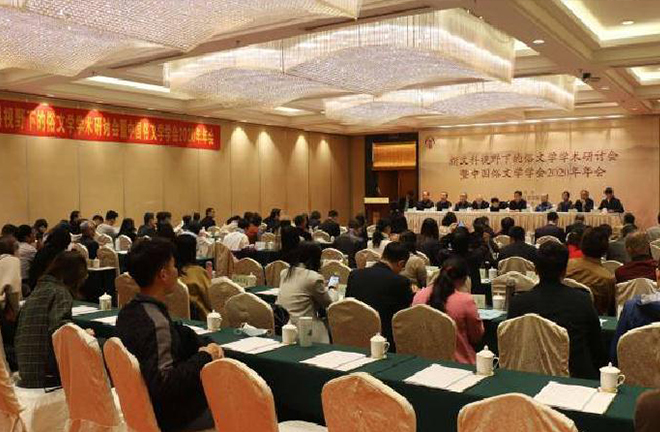Seminar imparts values of popular literature

The seminar on popular literature recently held in Yangzhou, Jiangsu Province Photo: Wu Nan/CSST
At a seminar on popular literature recently held in Yangzhou, Jiangsu Province, scholars conducted in-depth discussions on such topics as the compilation and research of popular literature documents.
Popular literature includes folk literature created orally by the people and popular literature written by literati in the form of folk literature, said Duan Baolin, a professor from the Department of Chinese Language and Literature at Peking University. Popular literature is fundamental to literature. Despite an aggregate of crude works, popular literature also includes many high-quality works, which can be uncovered via long-term collective transmission and processing.
Popular literature reflects the lives, thoughts, and emotions of the general public, which is a research focus for understanding a nation and its people. According to Liao Kebin, a professor from the Department of Chinese Language and Literature at Peking University, current popular literature of China mainly refers to works produced before the 1911 Revolution, or the Xinhai Revolution. Popular literature in a broad sense includes ancient novels, operas, shuochang literature (literally tell-sing literature, an art form that utilizes talking and singing to tell stories), folk ballads, folk tales, and so on. In a narrow sense, popular literature refers to shuochang literature.
The various genres of shuochang literature are deeply rooted in folk life, and condense traditional society's values, national psychology, and lifestyles, including Pinghua (monologue story-telling in a local dialect), Daoqing (a folk operetta originated from the chanting of Taoist scriptures), Baojuan ( literally precious scrolls, a genre of prosimetric texts of a religious or mystical nature, often written in vernacular Chinese), Tanci (literally plucking rhymes, the singing of verse portions to a pipa, which consists of both spoken storytelling and sung ballads), and Guci (drum lyrics).
The study of popular literature can correct academic circles' contempt for popular literature and construct a more complete framework for Chinese literature. We can thus better understand generation mechanisms, the trajectory of changes, and motivation for development of popular culture. In addition, revealing the internal connection between popular literature and folk beliefs, enlightenment, and entertainment can deepen understanding of the composition and changes of national psychology, providing a reference for cultural construction in the new era, said Wang Dingyong, director of the Popular Literature Research Center at Yangzhou University.
Despite its long history, the study of popular literature did not truly enter the halls of modern academia until after the May Fourth Movement of 1919. According to Liao, after the movement, many representative research works on popular literature appeared, such as Wang Guowei's History of Traditional Opera in the Song and Yuan Dynasties, Lu Xun's A Brief History of Chinese Fiction, Hu Shih's Textual Research on Chinese Zhanghui-Style Fiction, and Zheng Zhenduo's History of Chinese Folk Literature.
In terms of methodology, On Destiny of Rebirth (1959) by Chen Yinque is a paragon of popular literature studies.
Since the 1980s, the study of popular literature witnessed a new wave. Fiction and operas have become important objects for research on ancient literature, while shuochang literature and folk ballads have received increasing attention.
Up to now, there have been large-scale or thematic literature compilations in the fields of fiction and opera. In terms of shuochang literature, Tanci, Baojuan, Zidishu (literally bannermen tales, a popular storytelling genre created in early 18th-century Beijing), and Muyushu (a genre of Tanci in Cantonese) have received growing attention. Academic circles have launched a series of research projects and completed an abundance of data compilations, Liao continued.
The survival and preservation of various popular literature genres varies greatly, Wang said. On the one hand, early shuochang literature such as Bianwen (a form of storytelling literature which flourished in the Tang Dynasty), Zhugongdiao (popular in the Song and Yuan dynasties, 960–1368), and Taozhen (prevalent in the Song Dynasty, 960–1127) have disappeared. On the other hand, some of them still exist, including Shuoshu (monologue storytelling), Daoqing, and Baojuan, as well as Tanci and Guci.
The study of different popular literature genres has an uneven status quo. Fiction and operas have become independent subjects, with many researchers involved, while shuochang literature research is largely niche, though it clings on to the subjects of ancient and modern literature. Shuoshu has a natural kinship to popular fiction, especially to Zhanghui-style fiction (a type of traditional Chinese fiction where each chapter is headed by a couplet giving the gist of its content). Therefore, Shuoshu has received attention from fiction researchers. In contrast, studies of other literary forms are still unpopular, mainly because of a lack of literature.
Shuochang literature has a history of more than two thousand years. This matrix of opera and fiction contains high research value. However, most related research needs to be strengthened, despite growing attention paid to Zidishu and Baojuan. The time frame for popular literature research should be extended into the 1930s and 1940s, suggested Bao Zhenpei, a professor from the School of Literature at Nankai University. Scholars should carry out integrative studies between popular literature and dialect-related intangible cultural heritage that is still actively inherited.
Edited by YANG LANLAN
